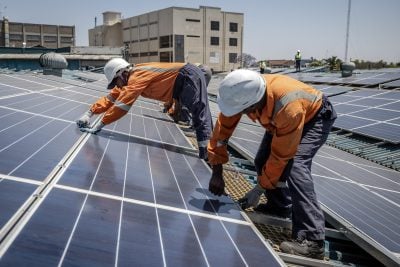For centuries, Africa’s niche in the world economy has been as a supplier of raw materials. To this day, outsiders come to Africa primarily to extract its minerals and other resources; only rarely do investors look for opportunities to harness the continent’s industrial potential. The energy transition, the great economic shift of the twentieth century, could reinforce this paradigm – or it could, finally, break it.
There is no doubt that Africa will play a key role in the energy transition, if only because of its energy and raw materials. The continent possesses 39% of the world’s renewable energy potential. Large swathes of Africa, particularly around the Sahara, offer some of the best conditions for solar power globally. There are already multiple projects to construct subsea electricity cables from Africa to Europe, which will allow electrons generated in North Africa to provide power for European industries.
Beneath the ground, meanwhile, Africa boasts an abundance of minerals such as cobalt, copper, iron ore, bauxite and many others. As a result, the continent is playing an increasingly vital role in global supply chains, including for electric vehicles. But the processing of Africa’s minerals mostly happens outside the continent, particularly in China.
Africa does, however, have a chance to scale up its value-added industries at the outset of the energy transition. Many African countries are well positioned to become major producers of green hydrogen, using electrolysis powered by renewable energy. While this green hydrogen could simply be exported, possibly in the form of green ammonia, there are strong advantages to using the resource instead locally, as a feedstock for heavy industries.
Turning the green industrial revolution from a dream into a reality for Africa is an epic task, fraught with risk and complexity; but a task that offers the reward of redefining the continent’s place in the global economic order.
Green potential
Rolling out renewable energy, alongside industries that can be powered by green electricity, offers huge economic benefits for Africa.
In fact, green industrialisation is a key step towards realising Africa’s renewable energy potential. In many cases, it is not economically viable to connect renewable energy resources to a national electricity grid, due to a lack of demand. However, the equation changes when an industrial facility can step in to become an offtaker of the power.
“To unlock that renewable energy potential, you do require anchor demand, you do require the heavy energy industry and the consuming industry that makes it bankable to invest in renewable energy,” says Jack Kimani, CEO of the Climate Action Platform for Africa (CAP-A), which is seeking to promote growth of green industries on the continent.
Related articles
- Africa set to enter electric vehicle industry
- Africa Climate Summit concludes with demand for investment in green energy
- Green hydrogen can power Africa’s economic growth
Providing renewables can be fully harnessed, industry in Africa can gain a significant competitive edge through lower power costs. CAP-A estimates that an electricity system featuring solar, wind and battery storage would cost 50% more in Spain (Europe’s leading renewable energy location) compared to Kenya, and 17% more compared to Nigeria. This reflects how solar energy can deliver a very reliable supply of power across large parts of Africa, meaning much less battery storage capacity is required.
And, of course, the prospect of green industrial growth also offers obvious benefits for Africa’s broader development.
“We see a massive opportunity for job creation,” says Sanjeev Debipersad, director of investments and advisory services at the Africa Enterprise Challenge Fund, a financing platform. He adds that renewable energy can provide a “multiplier effect” in stimulating the growth of enterprises, including those in light manufacturing industries, that often struggle to access a reliable power supply at present.
Hydrogen rush
Green hydrogen is a particularly crucial resource, as it can be used as a zero-carbon source of power for industries that are difficult to fully electrify. These include steelmaking, chemicals, fertilisers and plastics. Green hydrogen can also produce fuels for heavy-duty forms of transport, including aviation, shipping and trucks.
Debipersad notes that, at least in theory, it could be relatively straightforward for some industries to convert to use green hydrogen.
“All you’re changing is one component of your generation mechanism,” he points out. Debipersad adds that, despite the need for a major upfront investment, green hydrogen could significantly reduce operating costs for some industries.
“It really gives Africa a fantastic opportunity to truly leapfrog and join in the green energy revolution,” he says. “The solar radiation in Africa is incredibly strong, which means Africa should be the most competitive producer of green hydrogen,” says Amal-Lee Amin, head of climate, diversity and advisory at British International Investment, the UK’s development finance institution. “There’s been much talk about exporting hydrogen itself, but I think – and many are starting to recognise – that it should incentivise more of the value-add.”
Whether governments prioritise using green hydrogen to drive industrial development remains to be seen. Namibia, for example, is one of the leaders in Africa’s green hydrogen race. The government has already secured a deal with Hyphen Hydrogen Energy, a venture part owned by German investors, to develop a $10bn project to produce green ammonia in the country – but the output would mostly be exported to Germany and other overseas markets.
Green ammonia is produced using green hydrogen along with nitrogen from the atmosphere. It is much easier to transport by ship than is hydrogen gas, and it can be split back into green hydrogen and nitrogen after it arrives at its destination.
While projects such as this clearly offer economic benefits to countries like Namibia, they could be viewed as a missed opportunity to use green hydrogen to produce higher value goods locally.
Amin says it is possible to use green hydrogen to kickstart green manufacturing on the continent. “I’m a believer that it can happen at scale in Africa,” she says, but adds that this will depend on “both political leadership and targeted support for investment, particularly from the development finance community”.
Amin also notes that green industries in Africa could secure another “competitive advantage” through the EU’s Carbon Border Adjustment Mechanism (CBAM). This regulation requires companies that import goods into the European Union to report on the carbon emissions embedded in their products; and from 2026 companies will pay a “border tax” depending on their level of “carbon intensity”.
In other words, companies that can export low- or zero-carbon products to the EU market will have an advantage over their higher-emitting competitors. Iron, steel, aluminium and cement are among the first sectors to be covered by the regulation. Energy consultancy Wood Mackenzie estimates that CBAM could increase the cost of steel imported into the EU from India by 56% by 2034, while the cost of Chinese steel will rise by 49%.
With a potentially favourable route to the EU market for low-carbon goods, Kimani tells us that CBAM could be a “complete game changer” for Africa’s nascent green industries. “We have an opening to be able to go green from the start,” he says.
Heavy metal
Steel is one of the world’s most important industries. A strong steel industry provides a foundation for a country’s industrial development, given that the metal is widely used across a range of sectors.
But steelmaking is also highly polluting. The industry is to blame for around 7-9% of the world’s total greenhouse gas emissions.
Green hydrogen is key to the decarbonisation of the sector. Green hydrogen can be used as a reducing agent to remove oxygen from iron oxide ore in the process known as direct reduction iron (DRI). Meanwhile, electric arc furnaces – which can be powered with renewable energy – are much greener than traditional blast furnaces, which rely on burning metallurgical coal to generate the heat needed for smelting.
Kimani points out that several countries in Africa have the ingredients needed to produce green steel or green aluminium, including green hydrogen potential along with reserves of iron ore and bauxite (aluminium ore) respectively. He is not aware, however, of any companies that are considering “in a serious way” investing in these industries in Africa.
This is partly because the technologies for producing green steel and aluminium remain relatively nascent. But Kimani notes that, among the investors that are likely to be looking at green metal production, Africa would not be a “default destination”. He stresses that there is much work to be done to create an “enabling environment” to encourage investors to take a multi-billion bet on green metal production on the continent.
Simon Nicholas, lead energy finance analyst for the steel sector at the Institute for Energy Economics and Financial Analysis, says that Africa does have a major advantage in that several of its iron ore deposits, including the giant Simandou project currently being developed in Guinea, contain high-grade iron ore that is suitable for DRI.
But he says that Africa may be better positioned for producing “green iron”, rather than green steel. This would involve carrying out the direct reduction process closer to the mine sites using green hydrogen, then exporting the green iron – which Nicholas says “now seems to be quite seriously emerging as a future trade commodity” – to electric arc furnaces overseas. This approach would have the added advantage of reducing the cost of shipping iron ore around the world.
ArcelorMittal signed a memorandum of understanding last year with an iron ore mining company in Mauritania to evaluate the possibility of developing a DRI production plant in the country.
Nicholas cautions that it would be harder to undertake the whole process of steelmaking within Africa, partly because of intense competition from other markets, including Brazil and the Middle East. Meanwhile, governments in established steel producing countries are typically determined to protect their steel industries. Former US president Donald Trump felt compelled to release an all-caps Tweet in 2018, warning: “IF YOU DON’T HAVE STEEL, YOU DON’T HAVE A COUNTRY!”
Familiar obstacles around infrastructure, the availability of an appropriately trained workforce, and access to finance could also hold back green steel production in Africa, says Nicholas. He notes that prospects for establishing a DRI facility around Simandou, for example, are uncertain.
“The big question is whether they’re going to have the infrastructure in place and the finance in place, given the high risks involved in places like Guinea,” says Nicholas, referring to the 2021 coup that saw a military junta seize power in the country. “It’s a risk which makes finance expensive.”
‘Window of opportunity’
There are certainly signs that policymakers are beginning to recognise the extent of the opportunity available to Africa. Notably, the Nairobi Declaration issued at the Africa Climate Summit in September saw governments commit to “advance green industrialisation across the continent by prioritising energy-intense industries to trigger a virtuous cycle of renewable energy deployment and economic activity, with a special emphasis on adding value to Africa’s natural endowments”.
Kimani acknowledges the risk that Africa will remain stuck in its traditional position as a raw materials exporter during the energy transition. If a green industrial revolution is to transform the continent, the pieces are not going to fall into place by themselves. “We need to put in the work. We need to be strategic,” he says.
But Kimani is optimistic that the continent does have a “window of opportunity” to move up the value chain and reframe its place in the global economic system through green industrialisation. “Africa can be viewed through a different lens,” he says. “It can be viewed through a lens of opportunity.”
Want to continue reading? Subscribe today.
You've read all your free articles for this month! Subscribe now to enjoy full access to our content.
Digital Monthly
£8.00 / month
Receive full unlimited access to our articles, opinions, podcasts and more.
Digital Yearly
£70.00 / year
Our best value offer - save £26 and gain access to all of our digital content for an entire year!

 Sign in with Google
Sign in with Google 



